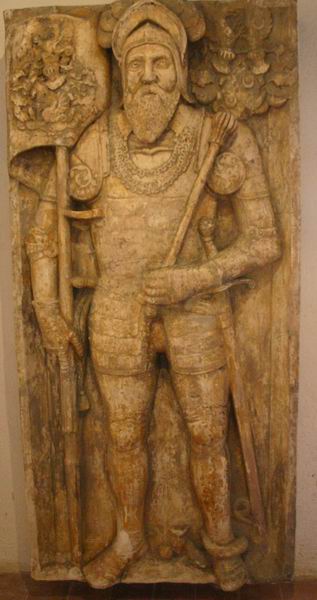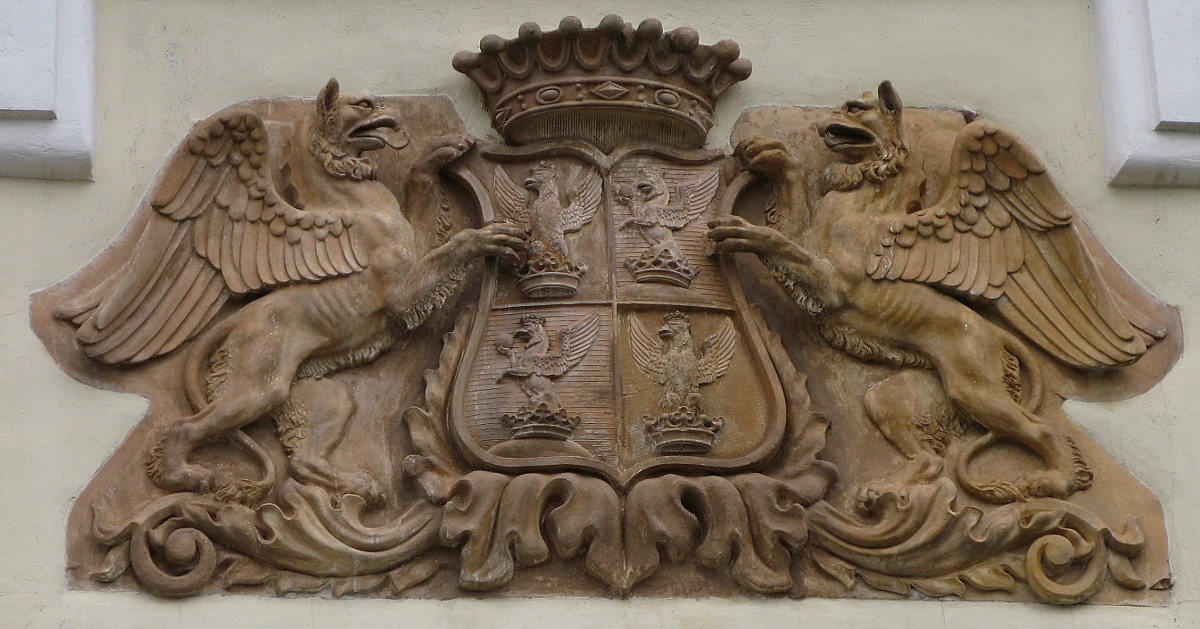|
Ivan Lenković
Ivan Lenković (died 22 June 1569) was a Habsburg Croatian army general and the leader of the Uskoks. He carried the title of baron. He is noted for the construction of Nehaj Fortress and as a captain of the Senj area.Bousfield (2003), p. 227. He also contributed in organizing the Military Frontier. During the Ottoman wars in Europe, Klis Fortress was on 7 April 1569, liberated by Split noblemen Ivan Alberti and Nikola Cindro.Listeš (1998), pp. 1–169. Bey Mustafa responded by bringing under Klis Fortress more than 10,000 soldiers. General Ivan Lenković with 1,000 uskoks came in relief, to some 1500 Klis defenders. During the battle, Ivan Lenković withdrew, after he himself was wounded, and the fortress was delivered to the Turks, on 31 May. But this temporary relief resound in Europe, and among the local population. He died in Metlika on 22 June 1569 and is buried in Novo Mesto Franciscan Church. See also *Uskoks *Fortress Nehaj *Petar Kružić Petar Kružić ( ... [...More Info...] [...Related Items...] OR: [Wikipedia] [Google] [Baidu] |
Novo Mesto
Novo Mesto (; sl, Novo mesto; also known by other alternative names) is a city on a bend of the Krka River in the City Municipality of Novo Mesto in southeastern Slovenia, close to the border with Croatia. The town is traditionally considered the economic and cultural centre of the historical Lower Carniola region. Name Novo Mesto was attested in historical sources in 1365 as ''Růdolfswerde'' (and as ''Rudolfswerd'' in 1392 and ''Noua Mesta'' in 1419). The German name (spelled ''Rudolfswerth'' in the modern era) is a compound of the personal name ''Rudolf'' and ''wert'' 'island, peninsula, land above the water', and refers to Rudolf IV, Duke of Austria, who conferred town rights upon the settlement in 1365. The parallel German name ''Neustadtl'' was also in use (attested as ''Newestat'' in 1365, and probably a translation of the Slovene name). The name used for the settlement before 1365 is unknown. The Slovene name ''Novo mesto'' literally means 'new town'; names like this ar ... [...More Info...] [...Related Items...] OR: [Wikipedia] [Google] [Baidu] |
Year Of Birth Missing
A year or annus is the orbital period of a planetary body, for example, the Earth, moving in its orbit around the Sun. Due to the Earth's axial tilt, the course of a year sees the passing of the seasons, marked by change in weather, the hours of daylight, and, consequently, vegetation and soil fertility. In temperate and subpolar regions around the planet, four seasons are generally recognized: spring, summer, autumn and winter. In tropical and subtropical regions, several geographical sectors do not present defined seasons; but in the seasonal tropics, the annual wet and dry seasons are recognized and tracked. A calendar year is an approximation of the number of days of the Earth's orbital period, as counted in a given calendar. The Gregorian calendar, or modern calendar, presents its calendar year to be either a common year of 365 days or a leap year of 366 days, as do the Julian calendars. For the Gregorian calendar, the average length of the calendar year (the mea ... [...More Info...] [...Related Items...] OR: [Wikipedia] [Google] [Baidu] |
Barons Of Croatia
Baron is a rank of nobility or title of honour, often hereditary, in various European countries, either current or historical. The female equivalent is baroness. Typically, the title denotes an aristocrat who ranks higher than a lord or knight, but lower than a viscount or count. Often, barons hold their fief – their lands and income – directly from the monarch. Barons are less often the vassals of other nobles. In many kingdoms, they were entitled to wear a smaller form of a crown called a ''coronet''. The term originates from the Latin term , via Old French. The use of the title ''baron'' came to England via the Norman Conquest of 1066, then the Normans brought the title to Scotland and Italy. It later spread to Scandinavia and Slavic lands. Etymology The word ''baron'' comes from the Old French , from a Late Latin "man; servant, soldier, mercenary" (so used in Salic law; Alemannic law has in the same sense). The scholar Isidore of Seville in the 7th century thoug ... [...More Info...] [...Related Items...] OR: [Wikipedia] [Google] [Baidu] |
16th-century Croatian Military Personnel
The 16th century begins with the Julian calendar, Julian year 1501 (Roman numerals, MDI) and ends with either the Julian or the Gregorian calendar, Gregorian year 1600 (Roman numerals, MDC) (depending on the reckoning used; the Gregorian calendar introduced a lapse of 10 days in October 1582). The 16th century is regarded by historians as the century which saw the rise of Western culture, Western civilization and the Gunpowder empires, Islamic gunpowder empires. The Renaissance in Italy and Europe saw the emergence of important artists, authors and scientists, and led to the foundation of important subjects which include accounting and political science. Copernicus proposed the Copernican heliocentrism, heliocentric universe, which was met with strong resistance, and Tycho Brahe refuted the theory of celestial spheres through observational measurement of the SN 1572, 1572 appearance of a Milky Way supernova. These events directly challenged the long-held notion of an immutable uni ... [...More Info...] [...Related Items...] OR: [Wikipedia] [Google] [Baidu] |
16th-century Croatian Nobility
The 16th century begins with the Julian year 1501 ( MDI) and ends with either the Julian or the Gregorian year 1600 ( MDC) (depending on the reckoning used; the Gregorian calendar introduced a lapse of 10 days in October 1582). The 16th century is regarded by historians as the century which saw the rise of Western civilization and the Islamic gunpowder empires. The Renaissance in Italy and Europe saw the emergence of important artists, authors and scientists, and led to the foundation of important subjects which include accounting and political science. Copernicus proposed the heliocentric universe, which was met with strong resistance, and Tycho Brahe refuted the theory of celestial spheres through observational measurement of the 1572 appearance of a Milky Way supernova. These events directly challenged the long-held notion of an immutable universe supported by Ptolemy and Aristotle, and led to major revolutions in astronomy and science. Galileo Galilei became a champion ... [...More Info...] [...Related Items...] OR: [Wikipedia] [Google] [Baidu] |
Croatian Nobility
Croatian nobility ( hr, plemstvo, lit=vlastelin; french: la noblesse) was a privileged social class in Croatia during the Antiquity and Medieval periods of the country's history. Noble families in the Kingdom of Croatia included high ranking populates from Slavonia, Dalmatia, Istria, and Republic of Ragusa. Members belonged to an elite social hierarchy, normally placed immediately behind blood royalty, that possessed considerably more privileges or eminence than most other classes in a society. Membership thereof typically was often hereditary. Historically, membership in the nobility and the prerogatives thereof have been regulated or acknowledged by the monarch. Acquisition of sufficient power, wealth, military prowess or royal favour enabled commoners to ascend into the nobility. The country's royalty was heavily influenced by France's nobility resulting members of the Royal Courts to assume French titles and practices during French occupation. The controversial assumption ... [...More Info...] [...Related Items...] OR: [Wikipedia] [Google] [Baidu] |
Croatian Soldiers
Croatian may refer to: *Croatia *Croatian language *Croatian people *Croatians (demonym) See also * * * Croatan (other) * Croatia (other) * Croatoan (other) * Hrvatski (other) * Hrvatsko (other) * Serbo-Croatian (other) Serbo-Croatian or Croato-Serbian, rarely Serbo-Croat or Croato-Serb, refers to a South Slavic language that is the primary language of Serbia, Croatia, Bosnia and Herzegovina, and Montenegro. Serbo-Croatian, Serbo-Croat, Croato-Serbian, Croato-Serb ... {{disambiguation Language and nationality disambiguation pages ... [...More Info...] [...Related Items...] OR: [Wikipedia] [Google] [Baidu] |
Petar Kružić
Petar Kružić (died 1537) was a Croatian knez, captain, soldier and defender of Klis, and the captain of Senj. In the early 16th century Petar Kružić ''(knez of Klis)'' defended the Klis Fortress against Turk invasion. He died in 1537 trying to break yet another siege of the Turks. After his death, the Klis defenders agreed to give the fortress to the Ottomans in exchange for their women, children and their own lives. In this way, the Ottomans finally conquered the Klis Fortress after almost two and a half decades of its successful defense. Origin He was a native of Krug in Nebljuh, a district of the same-titled tribe in the župa of Lapac in Lika. However, later chroniclers, and historians, mostly for local patriotic reasons, tried to appropriate and present him as one of their countrymen because he enjoyed incredible popularity as an anti-Ottoman fighter, especially in the areas from which Klis defenders came ( Poljica). Military career He began his military car ... [...More Info...] [...Related Items...] OR: [Wikipedia] [Google] [Baidu] |
Fortress Nehaj
The Nehaj Fortress ( hr, Tvrđava Nehaj ) is a Fortification, fortress on the hill Nehaj in the town of Senj, Croatia. The name ''Nehaj'' comes from the Croatian language, Croatian term ''Ne hajati'' , which means 'don't care'. In Croatian this fortress has also other names, which are: ''Kula Nehaj'' , what means ''Nehaj Tower'', and ''Nehajgrad'' , what means ''Nehajtown''. This name was given to the hill and the Fortress by the Uskoks, who built on the top of this hill the Fortress for defensive purposes. They gave the hill and the Fortress such a name because they wanted to emphasize to the citizens of the town of Senj, and all of those that lived in the vicinity of the town of Senj that they should not care that someone will conquer this hill or the Fortress until they are there. It was built by Croatian army general Ivan Lenković, a captain of the ''Uskoks'', on the hill Nehaj.Bousfield (2003), p. 227. [...More Info...] [...Related Items...] OR: [Wikipedia] [Google] [Baidu] |
Metlika
Metlika (; german: Möttling''Leksikon občin kraljestev in dežel zastopanih v državnem zboru,'' vol. 6: ''Kranjsko''. 1906. Vienna: C. Kr. Dvorna in Državna Tiskarna, p. 10.) is a town in southeastern Slovenia. It is the seat of the Municipality of Metlika. It lies on the left bank of the Kolpa River on the border with Croatia. It is in the heart of the area of White Carniola, the southeastern part of the traditional region of Lower Carniola. It is now included in the Southeast Slovenia Statistical Region. Name Metlika was first mentioned in written sources in 1228 as ''Metlica'' (and as ''Methlica'' in 1268 and ''Metlika'' in 1337). The name is derived from the Slovene common noun ''metlika'' 'goosefoot', thus referring to the local flora. In the past the German name was ''Möttling''. History Archaeological evidence has shown that the area has been settled since prehistoric times. From about 1205 it was incorporated into the Imperial March of Carniola and was granted tow ... [...More Info...] [...Related Items...] OR: [Wikipedia] [Google] [Baidu] |
Kingdom Of Croatia (Habsburg)
The Kingdom of Croatia ( hr, Kraljevina Hrvatska; la, Regnum Croatiae; hu, Horvát Királyság, german: Königreich Kroatien) was part of the lands of the Habsburg monarchy from 1527, following the Election in Cetin, and the Austrian Empire from 1804 to 1867. It was also a part of the Lands of the Hungarian Crown, but was subject to direct Imperial Austrian rule for significant periods of time, including its final years. Its capital was Zagreb. The Kingdom of Croatia had large territorial losses in wars with the Ottoman Empire in the 16th century. Until the 18th century, the kingdom included only a small north-western part of present-day Croatia around Zagreb, and a small strip of coastland around Rijeka, that were not part of the Ottoman Empire or part of the Military Frontier. Between 1744 and 1868, the Kingdom of Croatia included a subordinate autonomous kingdom, the Kingdom of Slavonia. The territory of the Slavonian kingdom was recovered from the Ottoman Empire, and was s ... [...More Info...] [...Related Items...] OR: [Wikipedia] [Google] [Baidu] |






